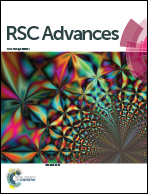Synthesis of poly(dimethylsiloxane)-block-poly[3-(triisopropyloxysilyl) propyl methacrylate] and its use in the facile coating of hydrophilically patterned superhydrophobic fabrics†
Abstract
We report the synthesis and applications of a novel poly(dimethylsiloxane-block-poly[3-(triisopropyloxysilyl)propyl methacrylate]) (PDMS-b-PIPSMA) diblock copolymer. PDMS-b-PIPSMA was synthesized via atom transfer radical polymerization (ATRP), and was characterized by 1H NMR and SEC analysis. This block copolymer was successfully grafted onto cotton fabrics via sol–gel chemistry using the PIPSMA block as an anchor to generate superhydrophobic fabrics. These superhydrophobic cotton fabric coatings were tested as membranes for oil–water separation, where water was retained on the surface of the hydrophobic cotton, while organic solvents permeated through this coated fabric. In addition, the batik technique was used to prepare superhydrophobic cotton fabrics that bore hydrophilic patterns. We demonstrated that water-based ink solutions readily wet the hydrophilic regions, but they were repelled by the superhydrophobic regions. These patterned fabrics may thus find applications as stamps for the imprinting of aqueous ink solution-based patterns onto other fabrics.
![Graphical abstract: Synthesis of poly(dimethylsiloxane)-block-poly[3-(triisopropyloxysilyl) propyl methacrylate] and its use in the facile coating of hydrophilically patterned superhydrophobic fabrics](/en/Image/Get?imageInfo.ImageType=GA&imageInfo.ImageIdentifier.ManuscriptID=C5RA02067K&imageInfo.ImageIdentifier.Year=2015)

 Please wait while we load your content...
Please wait while we load your content...